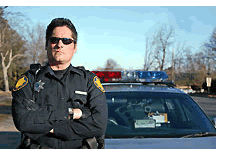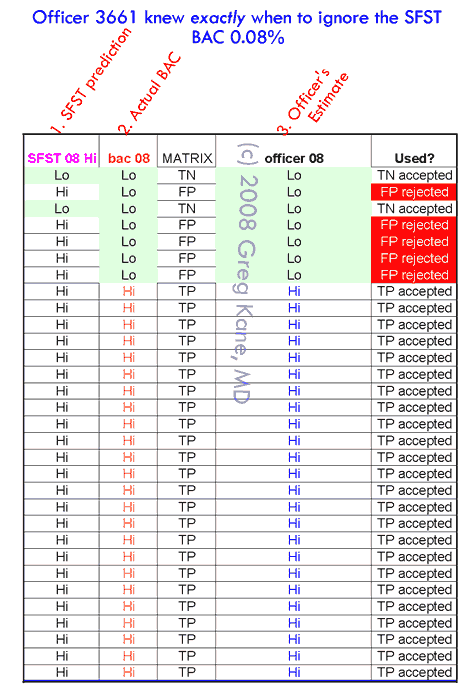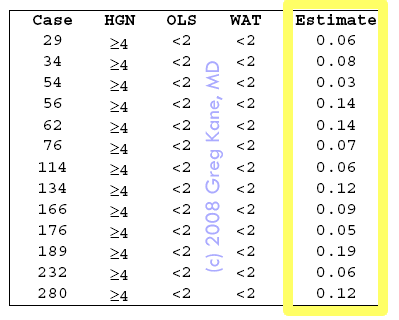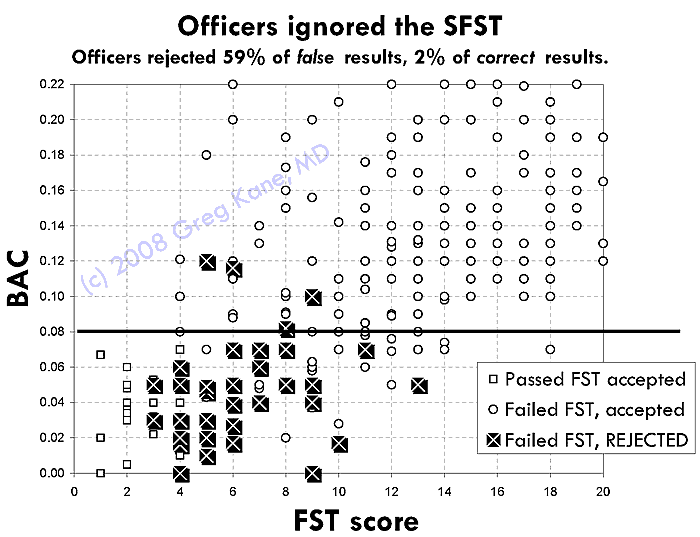
| The facts
Did I mention officers in this study had PBTs? And did PBTs on every driver? They did. Here's the thing. The officers (with PBTs) doing the study knew the SFST doesn't work, so they ignored it. When the SFST gave the wrong answer, the officers often changed the wrong answer to the correct answer. The guys doing the study knew the SFST doesn't work, so they ignored it. They fixed it's mistakes. They often changed wrong answers to right answers. Every wrong answer? No. But lots of them. |
|
Let me show you
Remember, SFST scores are not supposed to predict a specific BA level. All they do, supposedly, is predict BAC high or low. To match that theory this table simplifies SFST score according to NHTSA's standardized FST interpretation criteria, to "Hi" or "Lo." BAC the same, above or below the 0.08% limit SFSTs supposedly identify. NOTICE For the 7 innocent people the SFST gives the correct answer only 2 times. On innocent people the SFST is 30% accurate. Officer 3661's predictions were perfect. When the SFST gave the correct answer, that's the answer the officer gave too. But every single time the SFST gave the wrong answer, officer 3661 rejected that answer—corrected the wrong answer to the right one. Officer 3661's BAC high or low guesses match the PBT high or low results exactly. On innocent people Officer 3661 was 100% accurate. |
In court
On account of which people think SFST validation studies proved that officers, doing what the SFST told them to do, were 91 % accurate at classifying drivers' BACs. And the officer in this DUI case I'm the juror on right now, he also did exactly what the SFST told him to do. So he'll be 91% accurate too. But it's not true. Officers in the validation studies did not do what the SFST told them to do. They were as accurate as they were only because they ignored the SFST. The accuracy numbers NHTSA advertises are as high as they are only because someone changed the answers. If your D's jury believes NHTSA's false SFST accuracy claims, they will believe the SFST is more accurate than the science proves it really is. |
| Their project reports reveal that answer switching certainly happened in all three NHTSA SFST field validation projects, Colorado 1995, Florida 1997, San Diego 1998. Because NHTSA refuses to release data for the first two studies we can't be sure that the answer switching there improved the SFST's "accuracy." To do that, we need the study data. The one study we have data for does prove the "accuracy" bump, as I've explained. Again, this is all about science, not people. I'm not saying the police officers lied or cheated. They didn't. They were real officers doing real DUI stops. They did exactly what they were asked to do. They did exactly what they should have done—not arrest innocent people. Also I'm not saying NHTSA's contractors sneaked into the lab late at night and changed the data. They didn't. Also, I'm not saying the design of the study was deliberately deceptive. I do not know and I do not have an opinion about that. I don't care whether the error was deliberate or accidental. Water under the bridge. I care about the science. The science is flawed. |
|
|
This web site is about science—
NHTSA's SFST validation science. I do not know, I do not care, I
do not have an opinion about Dr. Jack Stuster's knowledge or intentions
at any time ever in his life. I'm not even saying he had knowledge
or intentions. But if he did, this web site isn't about them. Or him.
|

 But
that's not what NHTSA did. Details vary; here's how it worked for
the project I've
But
that's not what NHTSA did. Details vary; here's how it worked for
the project I've 

 Officer's estimates more precise than SFST criteria allow.
Officer's estimates more precise than SFST criteria allow.
